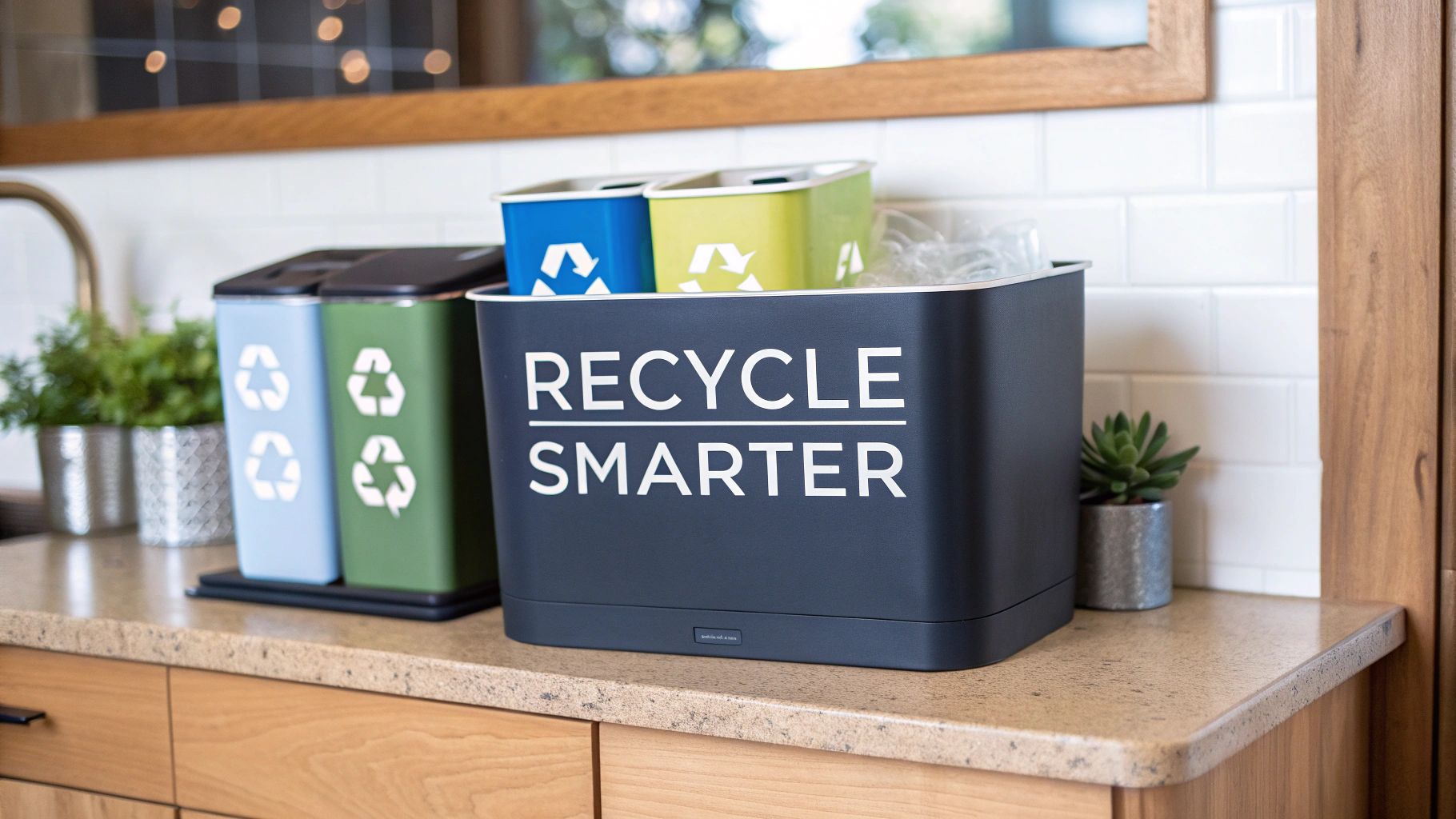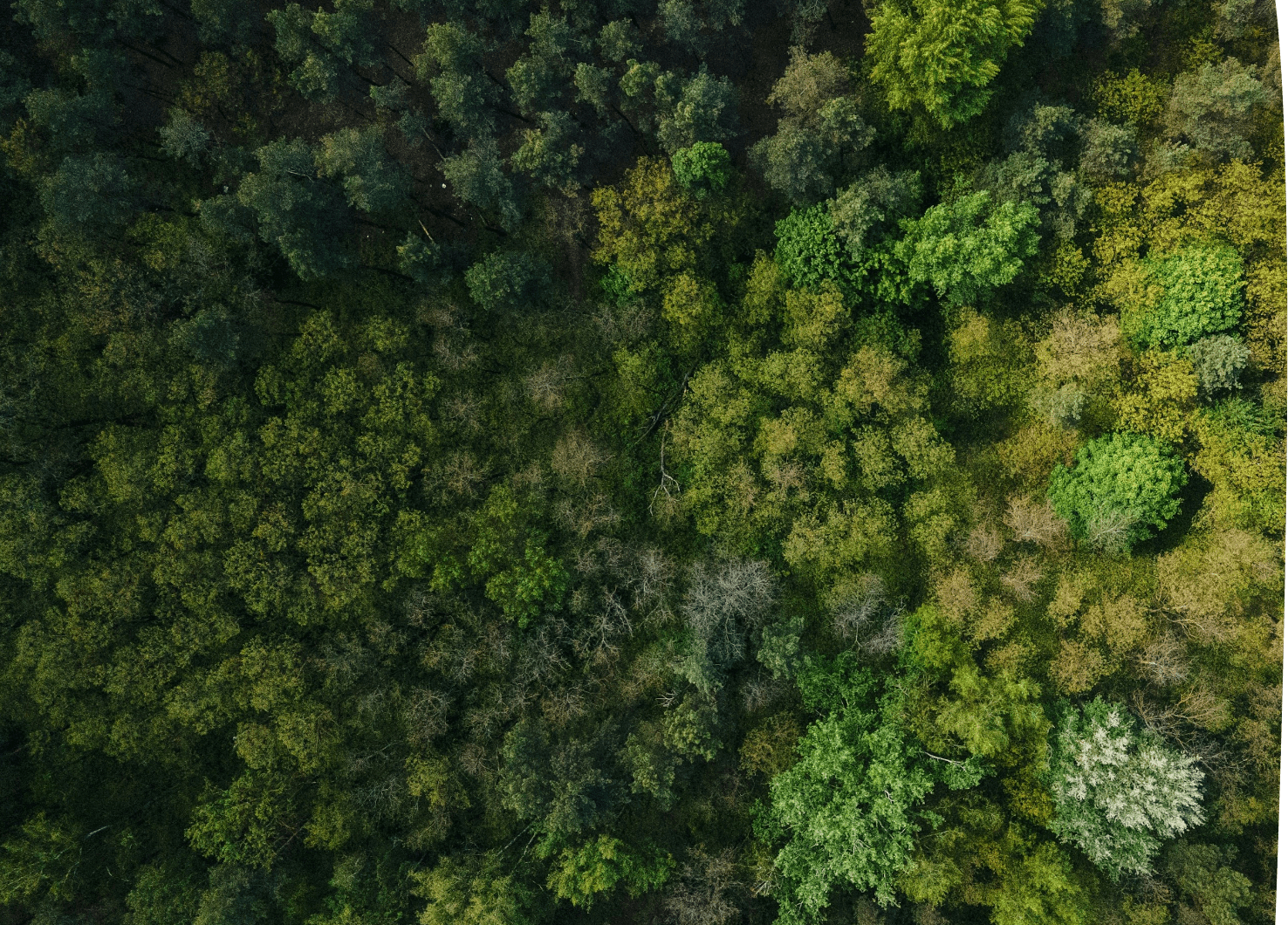A Guide to Circular Economy Waste Management
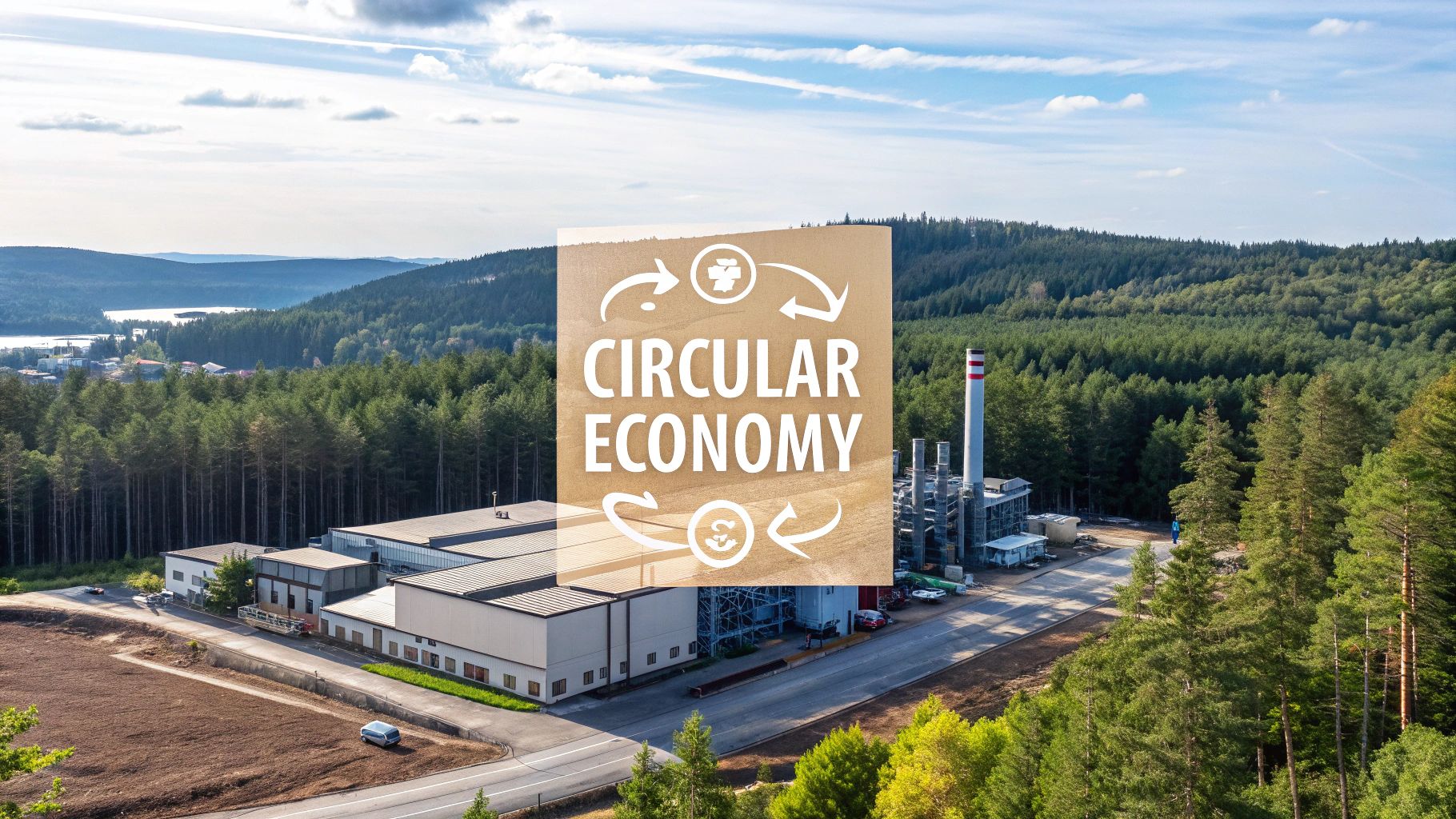
A Guide to Circular Economy Waste Management
Circular economy waste management completely flips the script on how we think about “rubbish”. It’s about creating systems where waste is designed out from the very beginning, and everything we use is kept in circulation for as long as possible. We’re moving away from simply recycling better and towards a closed-loop model where used materials aren’t seen as trash, but as valuable ingredients for the next new thing.
Moving Beyond the Throwaway Mindset
For generations, our economy has been a one-way street: take resources, make something, and then throw it away. This ‘take-make-waste’ model certainly fuelled growth, but it’s built on a shaky foundation – the idea that we have endless resources and a planet that can soak up infinite rubbish. We’re now seeing the cracks appear in overflowing landfills and struggling ecosystems.
This old linear system is fast becoming a dead end. In the UK alone, we generate millions of tonnes of commercial and industrial waste every year, piling immense pressure on our environment. This is where circular economy waste management steps in, offering a smarter, more resilient way forward.
The Forest Analogy
Think about a forest. When a tree drops its leaves or a branch falls, it’s not ‘waste’. It’s part of a cycle. It breaks down, enriches the soil, and provides nutrients for new life to spring up. In nature, everything is repurposed in a continuous, self-sustaining loop. That’s the big idea behind the circular economy – it’s about mimicking nature’s genius.
Instead of a straight line that ends in a bin, this model is a circle. The goal is to keep products and materials in use for as long as we can, wringing every last drop of value from them. Only then, at the very end of their life, do we look to recover and regenerate them into something new.
A circular economy is a systemic approach to economic development designed to benefit businesses, society, and the environment. In contrast to the ‘take-make-waste’ linear model, a circular economy is regenerative by design and aims to gradually decouple growth from the consumption of finite resources.
Shifting from Disposal to Design
This isn’t just a fancy way of talking about recycling. It’s a complete rethink of how we design, make, and use things, right from the drawing board. It forces us to ask some crucial questions before a product even exists:
- Can this be easily repaired instead of thrown out?
- Can its parts be taken apart and used in something else?
- Are the materials we’re using safe? Can they be returned to the earth without causing harm?
By building in durability, repairability, and reusability from the start, we can design waste out of the system before it’s even a problem. To really get a grip on breaking free from the old linear model, it’s worth exploring different circular economy business model strategies.
For UK industries, making this shift isn’t just an environmental nice-to-have; it’s a practical and profitable move. It cuts down our reliance on unpredictable raw material markets, slashes disposal costs, and opens up a world of opportunity for innovation in repair, remanufacturing, and new service-based businesses. This guide will walk you through the key ideas and strategies that can turn waste from a costly liability into a valuable asset.
The Three Pillars of a Circular System
To really get to grips with circular waste management, you need to understand the core ideas holding it all together. It isn’t just one single action; it’s a whole philosophy built on three interconnected pillars. When these three work in harmony, they create a tough, self-sustaining system that completely changes how we think about the stuff we use every day.
Think of it like a master chef with a ‘nose-to-tail’ menu. A great chef doesn’t just use the prime cuts and bin the rest; they find a clever use for every single part of an ingredient. This way of thinking isn’t just about cutting down on waste at the end of the line—it’s about designing a process where waste isn’t even created to begin with.
1. Design Out Waste and Pollution
The first pillar is all about being proactive: stop waste before it even starts. This means we need to stop focusing on end-of-pipe fixes like recycling and go right back to the very beginning of a product’s life—the design stage. We have to start asking tough questions about every single item we make. Is it built to last? Can it be taken apart easily for a quick repair? Are the materials non-toxic and biodegradable?
For instance, a company could design its packaging to be fully compostable, so it returns nutrients to the soil instead of just being recyclable. Another might build modular electronics where you can swap out a cracked screen in minutes, saving the whole device from the bin. This kind of upfront thinking is the bedrock of any solid circular waste strategy.
The image below shows how the classic ‘Reduce, Reuse, Recycle’ mantra fits into this modern approach, with a clear emphasis on preventing waste rather than just dealing with it.
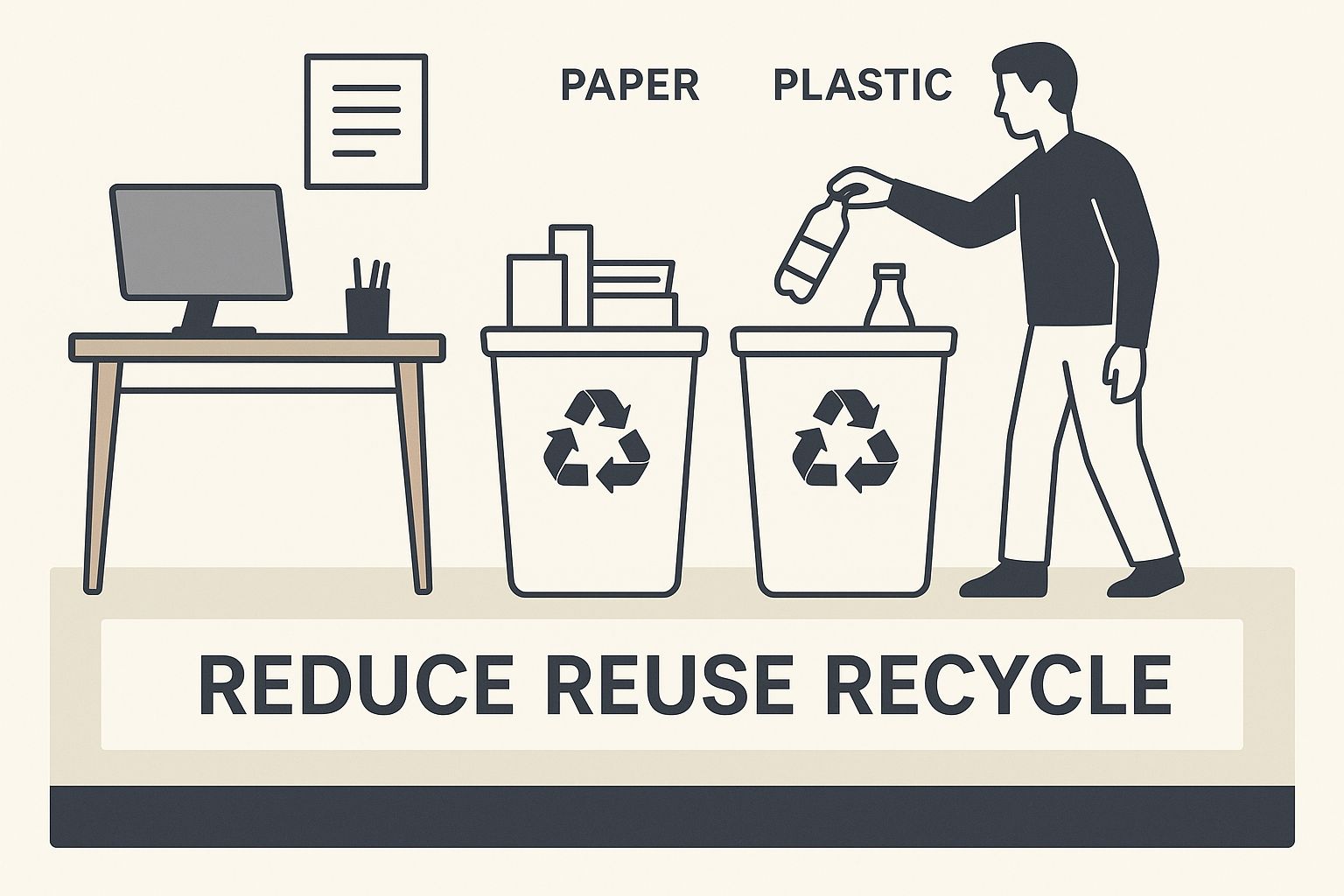
This really drives home the point that cutting down on what we buy and finding ways to reuse things are far more powerful than simply recycling them when we’re done.
2. Keep Products and Materials in Use
The second pillar is all about making things last. In our current linear economy, the goal is often just to sell more stuff, which has created a throwaway culture. The circular economy flips that on its head. The aim is to keep products and materials in circulation at their highest possible value for as long as possible.
This simple shift opens up a whole new world of business models that are good for the planet and the bottom line.
- Repair: Instead of replacing a dodgy appliance, businesses can offer cheap and easy repair services, giving it a new lease of life.
- Reuse: Giving items a second home is a core part of the circular economy. This is perfectly shown by businesses focused on used furniture that rescue quality pieces from landfill.
- Remanufacturing: This is a bit like a factory-approved restoration, bringing a product back to its original quality using a tiny fraction of the raw materials and energy.
- Sharing Models: Think about services that let you rent or share things you only use once in a blue moon—like power tools or a fancy suit. This makes sure every single product is used to its full potential.
These strategies turn products from one-off purchases into long-term assets that keep generating value. You can find more practical ideas in our guide to sustainable waste management strategies.
3. Regenerate Natural Systems
The final pillar is a crucial reminder that we’re a part of nature, not above it. Once we’ve squeezed every last drop of use out of our materials, the goal is to return them to the environment in a way that actually improves it. It’s about moving beyond ‘doing less harm’ and starting to make a genuinely positive impact.
In a truly circular system, the end of one product’s life is the beginning of another’s. Biological materials are returned to the earth to enrich it, while technical materials are recovered and remanufactured without loss of quality.
In practice, this means using non-toxic, biodegradable materials that can be safely composted—think mushroom-based packaging or fabrics made from leftover farm crops. When we return these biological nutrients to the soil, we help rebuild our natural capital, leading to healthier soil and more biodiversity.
To put it into perspective, the UK generates around 43.9 million tonnes of commercial and industrial waste every year, which just highlights how vital this shift is. It’s not all doom and gloom, though. The UK’s recycling industry already prevents over 18 million tonnes of CO2 from entering the atmosphere annually—that’s like taking 12 million cars off the road.
Putting Circular Waste Management into Practice
Getting your head around the theory is one thing, but actually translating circular economy ideas into real-world action is where the magic happens. This journey begins when we move beyond just “recycling” and start thinking about a whole hierarchy of strategies – often called the ‘Rs’ of circularity.
This isn’t some abstract list; it’s a practical toolkit for any business ready to rethink waste.
The hierarchy is all about prioritising actions that stop waste from even being created. This makes recycling the absolute last resort, not the first port of call. By working your way down the list, you can systematically shrink your environmental footprint and often find some serious cost savings along the way.
Let’s dig into how it works.
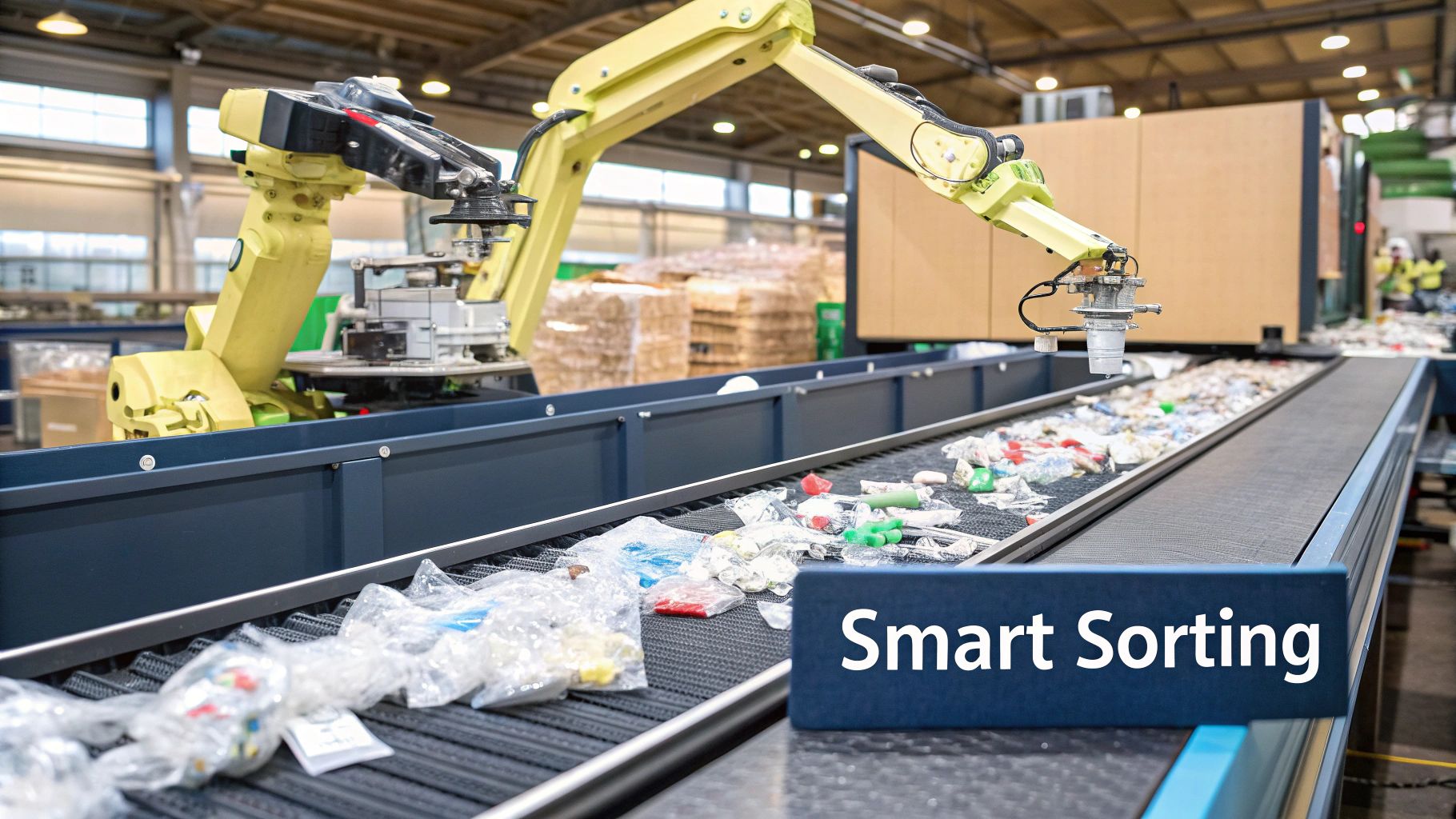
Start with Refuse and Reduce
The most powerful move you can make is simply to refuse. This means actively saying “no” to materials and products that are wasteful by design. It’s a proactive step that cuts waste off at the source, long before it even crosses your doorstep.
Think about a local cafe refusing deliveries from suppliers who use mountains of single-use plastic packaging. They could insist on reusable crates or compostable materials instead. That single decision sends a clear message to the market, nudging suppliers to clean up their act.
Next up is reduce. This is all about using less and being more efficient. It might mean redesigning a product to use less material without sacrificing quality, or tweaking a manufacturing process to create fewer offcuts. For businesses in the online space, where packaging waste is a huge issue, it’s worth exploring different strategies to make e-commerce eco-friendly.
Embrace Reuse and Repair
Once a product is out in the world, the goal is to keep it useful for as long as possible. This is where reuse shines. It’s about giving an item a second, third, or even fourth life without needing to break it down.
- For businesses: A restaurant switching from disposable paper napkins to washable linen ones.
- For you and me: Grabbing your reusable coffee cup every morning instead of a single-use paper one.
Hot on the heels of reuse is repair. Our throwaway culture has tricked us into thinking it’s normal to replace something the moment it breaks. A circular approach fights back by making repairs easy and affordable. That local shop offering smartphone screen replacements is a perfect example of the repair economy in action, saving a huge amount of valuable resources from the bin.
A truly circular approach sees a broken product not as rubbish, but as an opportunity. Repair extends its life, preserves the energy and materials locked inside it, and can even create skilled local jobs.
Refurbish and Remanufacture for Higher Value
When an item can’t be reused or repaired as it is, we move on to processes that are a bit more involved but still keep most of its value. Refurbish means restoring a product to good working order, often with a few cosmetic touch-ups. Think of certified pre-owned laptops that have been cleaned, tested, and resold with a warranty.
Remanufacture takes things a step further. This is an industrial-scale process where a used product is completely taken apart. Its components are cleaned, checked, and either repaired or replaced before being put back together to meet the original factory standards.
A company that rebuilds old industrial engines and sells them as good as new isn’t just recycling metal; it’s creating a whole new revenue stream from something that used to be scrap. This approach can save up to 85% of the energy and raw materials needed to make a brand-new product.
The Final Step: Recycling and Recovery
Only when all the other options have been tried should we turn to recycling. While it’s a crucial part of the puzzle, recycling often degrades the quality of materials (sometimes called downcycling) and uses a lot of energy. In a well-run circular system, it’s the last resort – reserved for when a product’s materials simply can’t be kept in their original form any longer.
By following this practical hierarchy, businesses can completely transform how they operate. It’s a vital step for any company wanting to learn how businesses can achieve zero waste to landfill, turning waste from a costly headache into a valuable resource.
How UK Policy Is Driving the Circular Transition
For the circular economy to really take hold and move from a niche idea to the way we all do things, businesses need a clear and steady hand guiding them from the top. Government policy provides that essential framework—encouraging, guiding, and sometimes demanding a shift away from our throwaway culture.
Across the United Kingdom, a series of key initiatives are laying the groundwork for a circular future. Think of these policies less as rules and more as catalysts. They’re designed to light a fire under innovation, creating financial nudges that make it more attractive for companies to design products that last, can be repaired, and are easily recycled. This teamwork between government and industry is exactly what we need to build a more resilient, resource-savvy UK economy.
The Upcoming UK Circular Economy Strategy
A huge leap forward is the government’s plan to launch a new UK Circular Economy Strategy. This isn’t just a minor update; it’s a major policy move aimed squarely at changing how the country manages resources and deals with waste.
Expected in 2025, the strategy will sharpen its focus on six high-impact areas where change is needed most:
- Textiles: Taking on the challenges of fast fashion and the mountains of clothing waste it creates.
- Transport: Pushing for remanufacturing and making sure vehicles have a much longer life.
- Construction: Tackling the enormous amount of waste from building and demolition sites.
- Agri-food: Cutting down on food waste and finding value in organic by-products.
- Chemicals: Making sure chemicals are used in a safer, more circular way.
- Plastics: Leading the charge away from single-use plastics and towards reusable alternatives.
This isn’t a one-size-fits-all approach. By zeroing in on these critical sectors, the strategy aims to deliver the biggest possible environmental and economic wins. You can get more information on this upcoming government confirmation and what it means for UK industries.
The real power of a national strategy like this is that it creates a predictable landscape for investment. When businesses know which way the wind is blowing, they can invest with confidence in the new tech and business models needed for the transition.
The Role of Extended Producer Responsibility
One of the most powerful tools in the government’s toolkit is Extended Producer Responsibility (EPR). It’s a simple but game-changing idea: the companies that make and sell products are made financially responsible for what happens to them when they’re no longer needed.
Picture a company that makes laptops. Under EPR, they pay fees based on how much packaging they use and how tricky their products are to recycle. This gives them a direct financial reason to do better. If they switch to less packaging or design their laptops to be easily repaired, their fees drop. It’s that simple.
This shifts the cost of dealing with waste away from local councils (and us, the taxpayers) and puts it back on the producers, who are the only ones who can design waste out of the system from the very beginning.
Creating a Market for Second-Hand Materials
Of course, it’s not enough to just collect and recycle waste. There needs to be a strong, stable market for the materials we recover. If nobody wants to buy recycled plastic pellets or crushed concrete, the whole system falls apart.
This is where policy can give things a much-needed push. The government can help by:
- Setting recycled content targets: This means new products, like plastic bottles or building materials, would have to contain a minimum amount of recycled material.
- Using public procurement: The government is a huge buyer of goods and services. By requiring its own departments and projects to buy products made from recycled materials, it can create massive, reliable demand overnight.
- Investing in recycling infrastructure: This means funding the development of top-tier sorting and processing plants that can turn our old stuff into high-quality materials ready for a new life.
These policies help to finally ‘close the loop’. They ensure the materials we all work so hard to recycle are actually turned back into valuable new products, transforming what we once called rubbish into a reliable domestic resource.
Overcoming Common Hurdles on the Path to Circularity

While the idea of a perfectly circular economy is inspiring, the journey to get there isn’t always straightforward. Moving away from the ‘take, make, dispose’ model we’ve used for generations takes more than just good intentions. It means facing up to some very real, practical obstacles.
For many UK businesses, these hurdles can seem pretty daunting, slowing down progress and making the whole thing feel overly complex. But here’s the thing: understanding these challenges is the first step to beating them. When we see the barriers clearly, they stop being roadblocks and start looking like opportunities for smart thinking.
Navigating Economic and Logistical Barriers
Let’s be honest, one of the first things any business thinks about is the cost. Shifting to a circular model often requires an upfront investment. You might need new equipment for sorting materials, different manufacturing processes, or a whole new system for taking products back. These initial costs can be a big hurdle, especially for smaller companies.
Then there’s the puzzle of reverse logistics. Getting products back from customers is a world away from the simple, one-way street of traditional sales. It means organising collections, setting up return points, and handling a flow of used goods that can be unpredictable. This requires careful planning and new systems that most businesses just don’t have in place yet.
“A common misconception is that the circular economy is just about recycling better. The reality is a complete operational rethink, particularly in how we manage the return and recovery of products. This is where the biggest challenges and the greatest opportunities for innovation lie.”
On top of all this, you have to contend with ingrained consumer habits. For decades, we’ve all been taught that convenience is king. It’s often easier to buy something new than to bother with repairing, returning, or reusing an old item. To change this, circular options need to be just as simple and appealing as their linear counterparts.
Understanding the Global Circularity Gap
These challenges help explain a pretty sobering statistic: the ‘circularity gap’. Despite all the talk, progress on a global scale has been slow. In 2025, the global circularity rate actually fell to just 6.9%. This means that of the 106 billion tonnes of materials used each year, less than 7% come from recycled sources. What’s more, this rate has dropped by 2.2 percentage points since 2015.
While that’s a global figure, you can get more insights on the global circularity rate at circularity-gap.world, and it really highlights the systemic problems that even advanced economies like the UK face when trying to scale up circular practices.
Turning Challenges into Competitive Advantages
The good news? Clever innovators are already tackling these issues head-on, turning what looks like a barrier into a genuine business opportunity.
- Technological Advances: New tech is making a huge difference. Advanced optical sorters and AI-powered robotics can process returned materials with incredible speed and accuracy, making recycling much more efficient and affordable.
- Collaborative Platforms: Businesses are realising they don’t have to go it alone. By teaming up on industry-wide take-back schemes or shared logistics platforms, companies can pool their resources, cutting costs and complexity for everyone.
- New Business Models: We’re also seeing clever new approaches emerge, like ‘product-as-a-service’. Instead of buying an item, customers lease it. This gives manufacturers a massive incentive to build things that are durable, easy to repair, and built to last.
By getting to grips with these hurdles, UK companies aren’t just boosting their green credentials. They’re building stronger, more efficient, and more profitable businesses for the long haul. Properly managing these processes also helps avoid problems like fly-tipping, which we cover in our article on the environmental impact of illegal dumping.
Your Questions on Circular Waste Management Answered
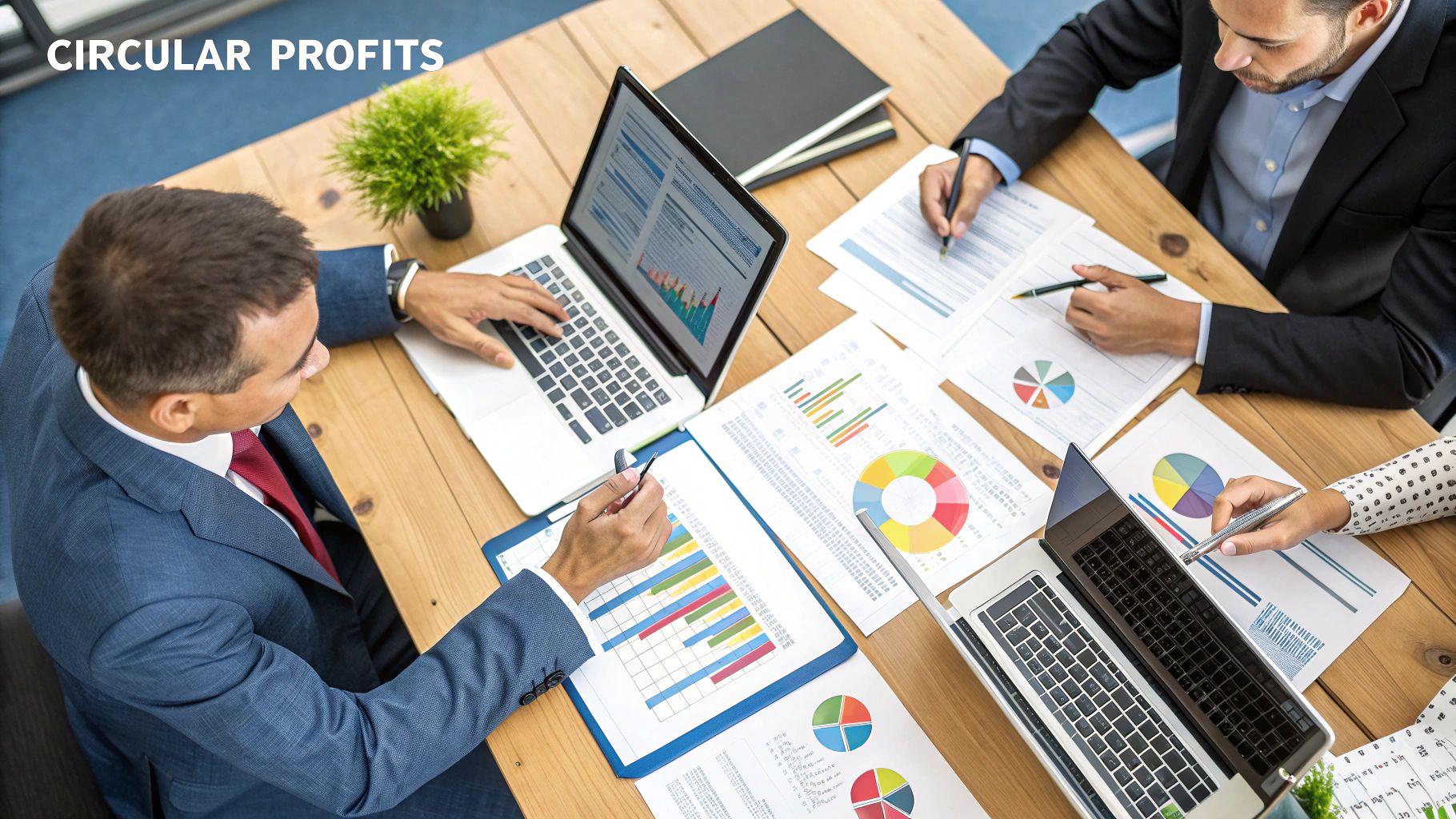
As the idea of a circular economy starts to really catch on, it’s only natural that practical questions pop up. Shifting from the old “take, make, dispose” mindset to a circular one means thinking and working in new ways. This section gets straight to the point, tackling the most common queries we hear from businesses and individuals across the UK.
Our goal is to give you straightforward, actionable advice, closing the gap between the big ideas and what you can actually do day-to-day. By clearing up these common uncertainties, we hope to make the move to circular waste management feel a lot more achievable.
What Is the Best First Step for a Small Business?
The most powerful first step is surprisingly simple: a waste audit. Before you can make any real changes, you need to know exactly what you’re throwing away.
For just one week, keep a close eye on every single item your business bins. Is your waste mostly cardboard from deliveries? Food scraps from the staff kitchen? Plastic wrap from your products?
This simple act of looking gives you solid data to work with. It instantly shows you where your biggest waste problem lies, so you can focus your efforts for maximum impact without feeling overwhelmed.
For instance, if packaging is the main culprit, you can start talking to suppliers about returnable containers or switching to recycled materials. If food waste is high, maybe it’s time to look into a local composting service. This approach turns a vague goal into a manageable project, targeting real problems with practical fixes.
How Is This Different from Just Recycling More?
This is a really important distinction. While recycling is a key part of circular economy waste management, it’s better to think of it as the last resort, not the main event. A truly circular approach is much bigger; it’s all about preventing waste from being created in the first place.
Recycling is what you do with waste after it already exists. A circular economy aims to design waste out of the system from the very beginning. It’s the difference between treating the symptoms and curing the cause.
Circular thinking starts way back at the design stage. It’s about making products that are tough, easy to fix, and designed to be taken apart later. The priority is to keep things and materials in use for as long as possible through repair, refurbishment, and remanufacturing.
Think of it like this: recycling is what we do with a single-use coffee cup when we’re done. A circular approach asks why the cup was single-use to begin with and pushes for reusable cups instead.
Are There Real Financial Benefits to Going Circular?
Absolutely. While some changes might need a bit of upfront investment, the long-term financial wins are significant. The most obvious benefit is simply cutting costs. By making less waste, businesses naturally spend less on disposal fees and buying new materials.
On top of that, designing products to last opens up completely new ways to make money. Offering affordable repair services or selling certified refurbished goods can create a whole new income stream from items that used to be considered junk. Being more efficient with resources also protects your business from fluctuating raw material prices, making you more resilient.
Beyond the direct savings, there are powerful benefits for your brand. Today, customers are actively looking for sustainable businesses. Embracing circular practices can lead to:
- Increased customer loyalty: People feel good supporting brands that share their values.
- A stronger brand reputation: A real commitment to sustainability is a brilliant marketing tool.
- Access to new markets: Many government and corporate contracts now give preference to suppliers with solid green credentials.
How Can I Contribute as an Individual?
Your personal choices are a massive driving force in the shift to a circular economy. Every time you buy something, you’re sending a message to the market. When lots of us act together, it puts real pressure on companies to change their ways.
You can get actively involved by making durability a priority in your own life. This means choosing to repair a broken toaster instead of buying a new one, looking for high-quality secondhand items, and supporting local businesses that offer product take-back schemes or use minimal packaging.
Renting things you only use now and then—like specialist DIY tools or a suit for a wedding—is another fantastic circular habit. It ensures the item gets used to its full potential by lots of people, rather than just sitting in your cupboard gathering dust.
Ultimately, by demanding products that are more durable, repairable, and reusable, we as consumers create the conditions that encourage companies to ditch the old throwaway model. Your actions help build the foundation for a more sustainable economy for everyone.
At The Waste Group, we are committed to helping homeowners and businesses manage their waste responsibly. Whether you’re clearing out a garden, renovating a property, or managing a commercial site, we provide reliable skip hire and waste management solutions to support your project. Find out how we can help you by visiting our website.
Learn more and book your skip today at The Waste Group.

